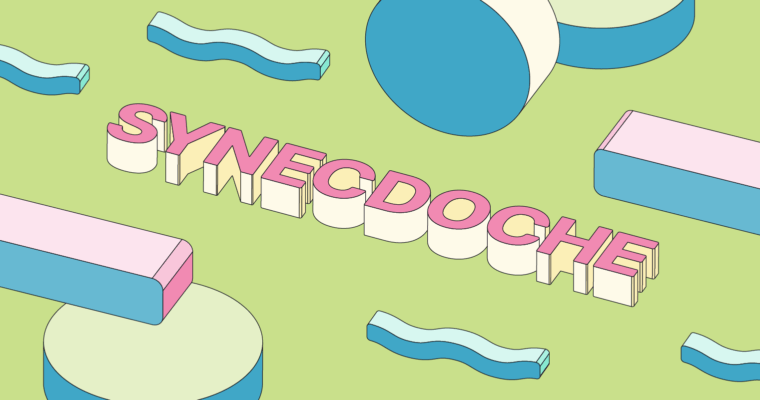
When you tell someone you’re going to “hit the books,” they probably picture you in a library or a study session. When you say you need “a set of wheels,” you’re indicating that you need a car (to get to said library, perhaps). These phrases are examples of synecdoche because they use part of something to stand in for the whole.
What is synecdoche?
Synecdoche (pronounced sin-ek-duh-kee) is a figure of speech in which a specific part of something is used to refer to the whole thing. It comes from the Greek word synekdoche, which means “simultaneous meaning.”
For example, using synecdoche, the word threads means clothing, heels means high-heeled shoes, and a suit is a businessperson who wears suits to work.
Synecdoche also works in the reverse direction by substituting the whole thing for a part. Although these examples are harder to come by, below we’ll look at some poems that use this technique.
How is synecdoche used?
Once you understand the definition of synecdoche, you’ll start to notice examples all around you. But besides being a cool literary term to know, what does synecdoche mean for your writing?
Synecdoche is often used in literature and poetry to create vivid, memorable images in a reader’s mind. For example, the synecdoche boots on the ground is frequently used to describe an army of soldiers marching, where the boots stand in for the whole soldier.
In The Hunger Games: Mockingjay – Part 1 by Suzanne Collins, the narrator describes being descended upon by an army:
“The wind whips the snow into blinding swirls but doesn’t block out the sound of another wave of boots headed our way.”
In this passage, the phrase “a wave of boots” combines metaphor with synecdoche to create the image of many soldiers stampeding toward the narrator.
Synecdoche can also be used to convey complex ideas more concisely.
For example, the poem “The World Is Too Much With Us” by William Wordsworth opens with this line:
“The world is too much with us; late and soon.”
In this case, Wordsworth is substituting the whole for the part. When he says “the world,” he is speaking specifically of human society and its material possessions (which becomes clear throughout the poem). To sum up that grand and complex subject in a few words, Wordsworth reached for synecdoche.
Overall, using synecdoche can help you improve your essays by creating memorable imagery and conveying complex ideas in a more concise way.
What’s the difference between synecdoche and metonymy?
Synecdoche and metonymy are closely related. Both figures of speech use one word to stand in for another. The difference is that metonymy uses a related word as a stand-in (e.g., calling the queen of England “the Crown”), while synecdoche uses a specific component or part of its stand-in (e.g., calling a car “a set of wheels”).
The phrase “hired helping hands” is synecdoche because hands stand in for a worker’s body, and hands are a portion of the body. On the other hand, “lend me your ears” is metonymy because what the speaker is asking for is not someone’s head, but their attention, and ears are not a unit of attention.
Some people consider synecdoche a subset of metonymy, since both function in the same way, but synecdoche has a narrower scope. In general, metonymy relies more on metaphor and symbolism, while synecdoche relies more on physical descriptions.
Examples of synecdoche
- Faces in the crowd = specific people in a crowd
- Mouths to feed = a group of hungry people
- Hit the road = leave
- Regular or decaf? = regular or decaf coffee
- Hand in marriage = marriage proposal
- All hands on deck = everyone must be available
- Press the flesh = greet people
- Order! = order in the court
- Faces in the crowd, where faces mean people
- Mouths to feed, where mouths mean hungry people
- Press the flesh, where flesh means hands, as in a handshake
Synecdoche FAQs
What is synecdoche?
Synecdoche is a figure of speech that substitutes a part for a whole or a whole for a part.
How is synecdoche used?
Synecdoche is used in writing to create vivid imagery or to make complex topics more concise and memorable.
What’s the difference between synecdoche and metonymy?
Both synecdoche and metonymy use substitution to create more engaging writing. Synecdoche substitutes a part for a whole, while metonymy substitutes a related object, concept, or idea.






